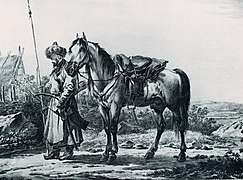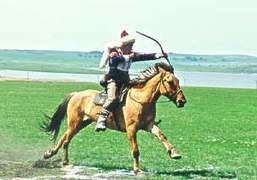Bashkir horse
The Bashkir is the horse breed of the Bashkir people. It is raised mainly within Bashkortostan, a republic within the Russian Federation which lies in the southern Ural Mountains and westwards. The principal centre of breeding is the capital, Ufa.[3]:334
Bashkir horses in the Southern Urals | |
| Conservation status | FAO (2007): not at risk[1]:98 |
|---|---|
| Other names | Russian: Bashkirskaya[2] |
| Country of origin | Russian Federation |
| Distribution | Bashkortostan |
| Traits | |
| Height | |
History
The origins of the Bashkir horse are not known. In the nineteenth century its economic value was recognised, and steps were taken to increase both its working abilities and its traditional qualities as a producer of milk and meat. Breeding centres were set up in 1845.[4]:88
The Bashkir horse has been crossed with other breeds of the former USSR such as the Russian Heavy Draught; experimental crosses with Kazakh and Yakut horses have also been made.[3]:333
Bashkortostan has the third-highest horse population of the federal subjects of Russia, after the Altai Krai and the Sakha Republic.[5] In 2003 the population of Bashkir horses was reported as 94,470.[2]
Characteristics
The Bashkir is a small horse, standing about 142 cm (14 hands; 56 inches) at the withers. It is wide in the body and deep-chested, with a thoracic circumference (girth) averaging about 180 cm (70 in); it has a large head and a short neck, low withers and a flat back. The legs are short with heavy bone; cannon bone measurement may reach 20 cm (8 in). The commonest coat colours are bay, chestnut, mouse grey and roan.[3]:333 The mane and tail are thick and the coat is also thick and often curly.[4]:88 A two-year study published in 1990 found it unlikely that the North American Curly Horse, which also has a curly coat and may be called "American Bashkir Curly", descends from the Bashkir breed.[6]
There are two distinct types of Bashkir horse: a smaller, lighter mountain type used mainly for riding, and a somewhat heavier steppe type.[4]:88
The Bashkir horse is remarkably hardy. Herds are managed extensively, and remain in the open in winter in snow and blizzard conditions where temperatures may reach -40°C.[4]:88
Uses
The Bashkir horse is used for riding and for pack, harness, draught and farm work. It shows remarkable endurance; there are reports of Bashkir horses drawing troikas, three-horse sleighs, over distances of 120–140 km (75–87 mi) per day.[4]:88
Bashkir mares are prolific producers of milk. Average yield per year is 1500[3]:333 or 2,100 kilograms (4,600 lb)[2] in a lactation of 240 days, with the best mares reaching 2,700 kilograms (6,000 lb). Much of the milk is made into kumis;[4]:88 kumis-making is a national activity of the Bashkiri people.[5]
Hair combed from the thick winter coat of the breed can be woven into cloth.[4]:88
 Horses at Tra-Tau Mountain in Ishimbaysky District
Horses at Tra-Tau Mountain in Ishimbaysky District Horses in Abzelilovsky District
Horses in Abzelilovsky District Bashkir horseman, by Aleksander Orłowski
Bashkir horseman, by Aleksander Orłowski Bashkir horseman
Bashkir horseman
References
- Barbara Rischkowsky, D. Pilling (eds.) (2007). List of breeds documented in the Global Databank for Animal Genetic Resources, annex to The State of the World's Animal Genetic Resources for Food and Agriculture. Rome: Food and Agriculture Organization of the United Nations. ISBN 9789251057629. Accessed October 2014.
- Breed data sheet: Bashkirskaya/Russian Federation. Domestic Animal Diversity Information System of the Food and Agriculture Organization of the United Nations. Accessed October 2014.
- N.G. Dmitriev, L.K. Ernst (1989). Animal genetic resources of the USSR. FAO animal production and health paper 65. Rome: Food and Agriculture Organization of the United Nations. ISBN 9251025827. Archived 13 November 2009. Also available here, archived 29 September 2017.
- Elwyn Hartley Edwards (1994). The Encyclopedia of the Horse. London; New York; Stuttgart; Moscow: Dorling Kindersley. ISBN 0751301159.
- Gljusa R. Bakijeva (2012). Evaluation of the Republic of Bashkortostan’s Tourism and Recreation Potential. Conference paper, 20th International Scientific Conference CO-MAT-TECH, 11–12 October 2012, Trnava, Slovak Republic. Accessed October 2014.
- S. Thomas (1990). The Curly Horse identification project of the CS fund conservancy (a case study), in: Lawrence Alderson (1990). Genetic conservation of domestic livestock. Wallingford, Oxon: CAB International, on behalf of the Rare Breeds Survival Trust. p. 154–159.